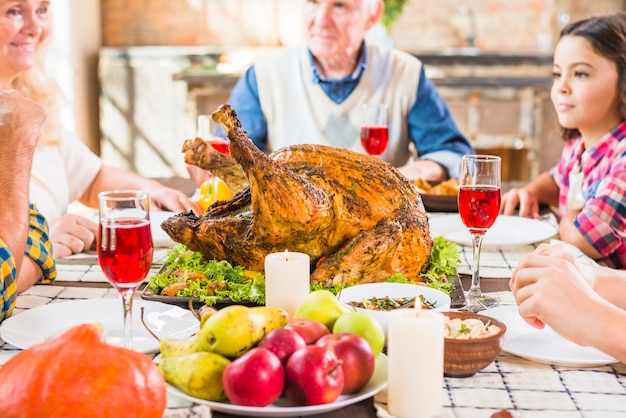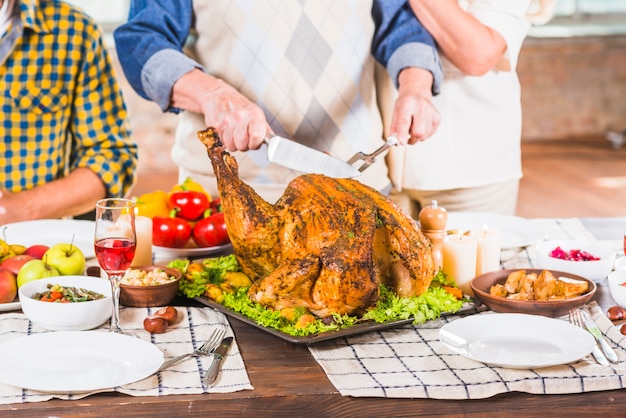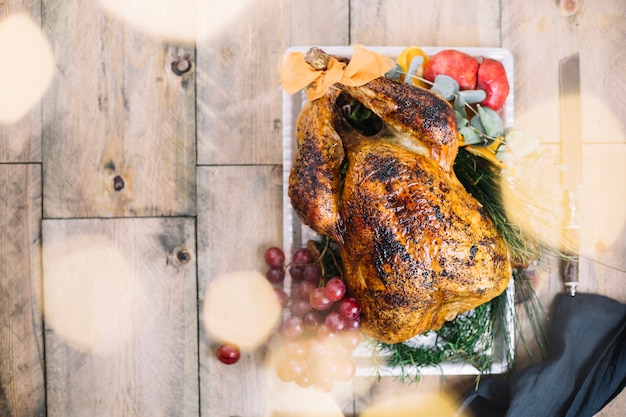Right, let’s talk turkey, shall we? As a seasoned chef (and a bit of a Christmas nut), I’ve roasted my fair share of turkeys. I've learned a thing or two about getting that beautiful golden brown skin and juicy, tender meat. And honestly, there's nothing quite like the feeling of satisfaction you get when you pull a perfectly roasted turkey out of the oven, the aroma filling your kitchen with the promise of a delicious feast.
Today, we're tackling the big one, a 19-pound turkey. That's a serious bird, folks, perfect for a proper festive gathering. But don't worry, it's not as daunting as it seems. With a little bit of know-how and a dash of confidence, you can knock this out of the park and impress everyone at the table.
This guide is going to break down everything you need to know, from prepping the turkey to figuring out the perfect cooking time. We’ll cover the dos and don'ts, along with some handy tips and tricks that will make your turkey the star of the show. Buckle up, and let’s get roasting!
(Part 1) Picking the Perfect Bird

The first step, and arguably the most crucial, is choosing the right turkey. It's like picking out the perfect Christmas tree – you want something that's going to be the centrepiece of your festive gathering.
The Weight Game
For a big family gathering, a 19-pound turkey is ideal. It's a generous size, ensuring you'll have plenty of leftovers for sandwiches and casseroles. My personal experience? A 19-pound turkey yields about 15-16 portions, which is enough to feed a good-sized crowd, and leaves you with enough for the inevitable turkey sandwich cravings the next day.
Fresh or Frozen?
Now, I'm a bit of a traditionalist and a big fan of fresh turkeys. There’s something special about the fresh, unfrozen flavour. However, a frozen turkey is perfectly fine if you can't find a fresh one. Just remember to give it plenty of time to defrost in the fridge – we're talking a couple of days here. Don’t even think about thawing it at room temperature, that’s a recipe for disaster, believe me! It's tempting to rush the process, but patience is key.
Brining Basics
Now, brining is a bit of a hot topic amongst turkey experts. Some swear by it, others say it's unnecessary. I fall firmly in the "brine-it-up" camp. Brining adds moisture and flavour, which is especially important for a large bird like this. It also helps to keep the meat tender and juicy.
If you're team "brine," use a simple salt and sugar solution. You can also add some spices like bay leaves or peppercorns for a bit of extra flavour. My favourite trick is to add a couple of oranges to the brine – it adds a subtle citrusy note that elevates the flavour.
Don't Forget the Turkey Butter
There’s something incredibly satisfying about slathering a big, juicy turkey with a generous layer of butter. I recommend using unsalted butter and blending it with a bit of garlic, rosemary, and thyme for a truly delicious flavour. A little secret? I sometimes add a pinch of smoked paprika for a touch of warmth and depth.
(Part 2) Getting Ready to Roast

Now that you’ve got your turkey prepped and ready to go, let’s talk about the roasting process. It's all about creating a symphony of flavours and textures.
The Big Reveal: Removing the Giblets
Once you’ve got your turkey out of the fridge, remove the giblets and neck from the cavity. You can use these to make a delicious gravy or stock later. You'll be surprised at the delicious flavour these little guys can add to your gravy!
Stuffing Saga
Stuffing is a classic Thanksgiving side, but it’s important to be careful about how you handle it. Stuffing the turkey can make it harder to cook evenly and can increase the risk of foodborne illness. The safest way to cook stuffing is to bake it separately. Trust me, you'll be happy you did!
The Oven Temperature
Now, here’s where the real fun begins. For a 19-pound turkey, you’ll want to cook it at a relatively low temperature – around 325°F (160°C). This ensures that the bird cooks evenly and doesn’t dry out. Think of it as a slow and steady approach to achieving perfection.
Oven Placement
Place your turkey in the centre of the oven on a roasting rack set inside a large roasting pan. This allows for even airflow and prevents the turkey from sticking to the pan. The roasting rack is a must-have for a perfect roast. It elevates the turkey, allowing hot air to circulate evenly.
Time to Rise
Now, here’s where the magic happens. The amount of time your turkey needs to roast depends on its weight.
(Part 3) The Turkey Timer: 19 lbs and Beyond

For a 19-pound turkey, you’ll want to roast it for approximately 3-4 hours, or until a meat thermometer inserted into the thickest part of the thigh registers an internal temperature of 165°F (74°C).
Don't Overdo It!
It's tempting to check the turkey every 15 minutes, but try to resist the urge. Opening the oven door frequently can cause the internal temperature to fluctuate, which can lead to uneven cooking. Just be patient, and let the bird cook undisturbed. Remember, good things come to those who wait!
The Basting Factor
While you're waiting, you can baste the turkey every 30-45 minutes with the pan drippings. This helps to keep the skin moist and creates a beautiful golden brown colour. It's a little bit of a ritual, and I find it incredibly satisfying.
The Rest is Golden
Once your turkey is cooked, it’s important to let it rest for at least 15-20 minutes before carving. This allows the juices to redistribute, resulting in a more tender and juicy bird. Think of it as giving the turkey a moment to relax and regain its composure.
(Part 4) Checking for Doneness
How do you know when your turkey is cooked through and ready to carve? There are a few tricks up our sleeve.
The Temperature Test
The most reliable way to check for doneness is with a meat thermometer. Insert the thermometer into the thickest part of the thigh, making sure it doesn't touch any bone.
The Pop-Up Thermometer
Some turkeys come with a pop-up thermometer in the breast. While it can be handy, it’s not always accurate, especially for a large bird. It's always best to rely on the tried and true method of the meat thermometer.
The Leg Test
Another good indicator is the leg test. If the leg moves easily and feels firm, the turkey is likely cooked through. If it’s wobbly or feels loose, it needs a little more time.
(Part 5) Carving Time: A Symphony of Turkey
With your turkey resting, it's finally time for the grand finale: carving.
Gather Your Tools
You’ll need a sharp carving knife, a cutting board, and a serving platter. I always recommend a good, sharp carving knife – it makes the carving process so much easier. And don’t forget to use a cutting board that’s large enough to accommodate the turkey.
The Carving Technique
First, remove the legs and thighs from the turkey. Then, carve the breast meat into thin slices. If you're feeling fancy, you can carve the breast into individual portions.
Presentation is Key
Arrange the turkey slices on your serving platter, and don't forget to drizzle some of the pan drippings over the top. This adds an extra touch of flavour and moisture.
(Part 6) The Gravy Gurus: Making the Perfect Sauce
No turkey feast is complete without a rich, flavorful gravy. It's the perfect complement to the turkey, bringing together all the flavours of the meal.
The Deglazing Power
The secret to a delicious gravy is deglazing the roasting pan. This means scraping up the browned bits that have stuck to the bottom. These browned bits, known as fond, are packed with flavour!
The Gravy Base
Use the pan drippings and a mixture of chicken broth, flour, and seasonings to create the base of your gravy. A good ratio is about 1 tablespoon of flour per cup of broth.
A Touch of Whimsy
You can add a splash of wine or a tablespoon of butter to enrich the flavour even further. I like to add a splash of red wine for a touch of depth.
The Final Touches
Simmer the gravy until it thickens, and then strain it through a fine-mesh sieve to remove any lumps. You want a smooth, velvety gravy that coats the turkey perfectly.
(Part 7) Leftover Love: Turkey Transformations
Don’t let those leftovers go to waste! There are endless possibilities for repurposing that delicious turkey meat.
The Classic Turkey Sandwich
Who doesn’t love a juicy turkey sandwich? You can serve it on sourdough bread with all your favourite toppings. I love to add a slice of cranberry sauce and a few slices of avocado for a touch of creaminess.
turkey soup Delight
Turkey soup is a classic comfort food. You can use leftover turkey, broth, vegetables, and noodles to create a flavourful and satisfying meal. Adding a dollop of sour cream or a sprinkle of fresh parsley gives it that extra touch.
Turkey Casserole Craze
Turkey casserole is a great way to use up leftover turkey and vegetables. You can layer them in a casserole dish and bake until bubbly and delicious. I like to add a layer of cheese on top for extra cheesy goodness.
turkey salad Sensations
Turkey salad is a versatile dish that can be served on bread, crackers, or lettuce. You can mix it with mayonnaise, celery, onion, and spices. For a festive twist, add a handful of dried cranberries or a sprinkle of chopped walnuts.
Turkey Shepherd's Pie Perfection
For a more hearty meal, try a turkey shepherd’s pie. You can use leftover turkey and vegetables as the base and top it with mashed potatoes. It's a satisfying and comforting meal that's perfect for a cold winter night.
(Part 8) turkey tips and Tricks
Here are a few extra tips and tricks to ensure your turkey is a triumph:
Time to Truss
Trussing your turkey helps to keep it in shape and cooks more evenly. It also helps to prevent the breast from drying out. There are many ways to truss a turkey. I find the easiest method is to use kitchen twine.
The Herb Garden
Adding herbs to your turkey stuffing or basting liquid can add a touch of flavour and aroma. Rosemary, thyme, sage, and parsley are all great choices.
The Golden Skin Secret
To achieve that beautiful golden brown skin, you can brush it with melted butter or olive oil before roasting. This will create a crispy and delicious skin.
Don't Forget the Sides
Don't forget the sides! A roasted turkey deserves some star-studded accompaniments. Mashed potatoes, stuffing, cranberry sauce, and gravy are all classic options. But don’t be afraid to get creative and experiment with new side dishes!
(Part 9) Turkey Feast: A Celebration of Flavour
A roasted turkey isn't just about the bird itself – it's about the whole experience.
The Festive Setting
Create a welcoming and festive atmosphere for your guests. Set the table with your best china and linens, and add some festive touches like candles and centerpieces.
Family and Friends
Gather your loved ones and enjoy the company. A turkey feast is a perfect opportunity to connect with family and friends.
The Joy of Sharing
Sharing a delicious meal is a wonderful way to connect with those you care about. Take the time to savor each bite and enjoy the company of your loved ones.
The After-Dinner Delight
Don't forget to save room for dessert. A pumpkin pie or a pecan pie is the perfect way to end a delicious turkey feast.
FAQs
Q1. How do I know if my turkey is done?
The best way to check if your turkey is done is with a meat thermometer. Insert it into the thickest part of the thigh, making sure it doesn't touch any bone. It should register an internal temperature of 165°F (74°C). If the thermometer isn't inserted deep enough, you might get a false reading.
Q2. How long should I let my turkey rest before carving?
Let your turkey rest for at least 15-20 minutes before carving. This allows the juices to redistribute, resulting in a more tender and juicy bird. Resist the urge to carve the turkey immediately. Trust me, it's worth the wait!
Q3. What should I do with the giblets?
You can use the giblets to make a delicious gravy or stock. Add them to a pot of simmering water with some vegetables for a flavorful broth.
Q4. How do I prevent my turkey from drying out?
Brining your turkey before roasting helps to keep it moist. You can also baste it with pan drippings during cooking. Don't forget to cover the turkey with foil for the first part of the roasting time to prevent it from drying out.
Q5. What are some good sides to serve with turkey?
There are endless possibilities for sides! Some classic options include mashed potatoes, stuffing, cranberry sauce, and gravy. But don’t be afraid to get creative and experiment with new side dishes!
Enjoy your turkey feast, and happy cooking!
Everyone is watching

Corn on the Cob: The Ultimate Guide to Perfectly Cooked Ears
Healthy MealsAh, corn on the cob. Just the name evokes images of sunny days, barbecues, and that sweet, juicy flavour that ...

Perfect Pork Roast Oven Cooking Time: A Guide to Delicious Results
Healthy MealsThere's something truly satisfying about a perfectly roasted pork. The aroma alone is enough to make your mout...

Ham Cooking Time: How Long to Bake, Smoke, or Boil a Delicious Ham
Healthy MealsAh, ham. It's a classic, isn't it? A real crowd-pleaser, especially around holidays. And when done right, it'...

Scallops: The Ultimate Guide to Perfect Cooking
Healthy MealsAh, scallops. Those delicate, sweet, and utterly delicious morsels of the sea. They hold a special place in my...

Spaghetti Squash: The Ultimate Guide to Cooking and Serving
Healthy MealsRemember that time you saw spaghetti squash at the supermarket, looking all bumpy and strange, and thought, "W...
